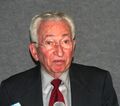Milestones:Invention of the First Transistor at Bell Telephone Laboratories, Inc., 1947
- Date Dedicated
- 2009/12/08
- Dedication #
- 89
- Location
- Murray Hill, NJ, U.S.A.
- IEEE Regions
- 1
- IEEE sections
- North Jersey
- Achievement date range
- 1947
Citation
Invention of the First Transistor at Bell Telephone Laboratories, Inc., 1947
At this site, in Building 1, Room 1E455, from 17 November to 23 December 1947, Walter H. Brattain and John A. Bardeen -- under the direction of William B. Shockley -- discovered the transistor effect, and developed and demonstrated a point-contact germanium transistor. This led directly to developments in solid-state devices that revolutionized the electronics industry and changed the way people around the world lived, learned, worked, and played.
The plaque may be viewed in the ‘Hall of Innovations’ near the transistor display, Bldg 6, Murray Hill, NJ, U.S.A.
Historical Significance
This was the beginning of solid state electronics which quickly reduced the size and power requirements of existing electronic tube based electronic devices. This revolutionized the electronics field and eventually ushered in the information age via small, low power electronic devices and eventually low cost integrated circuits.
It has been cited as the most important invention of the 20th Century, see reference i (4). It’s hard to imagine any field of human endeavor where it has not had a profound positive impact from communications, computing, transportation, medical, etc.
The invention of the first working transistor set the stage for all subsequent solid-state device developments. Although Julius Edgar Lilienfeld[1] successfully patented a number of field-effect transistor configurations starting in 1925 and into the 1930’s, there is no indication that he ever produced any working models. If he did, they would not have worked very well due to the state of germanium and silicon crystal growth at that time. By 1947,[2] advances in germanium semiconductors made it possible for Bardeen and Brattain to make the first working point contact transistor.
References
- ↑ The following from: http://chem.ch.huji.ac.il/history/lilienfeld.htm. Julius Edgar Lilienfeld proposed the basic principles behind the MOS field-effect transistor in 1925 in a patent filing. “ No one really knows whether Lilienfeld ever tried to build his device. Even if he did, the device would not have worked well, if at all, since the production of high quality semiconductor materials was still decades away. Thus, in the 1920s and 1930s, Lilienfeld’s solid-state amplifier ideas had no practical value to the radio industry. Like so many patents, Lilienfeld’s went into obscurity. Nevertheless, his ideas embody the principles of the modern-day, field-effect transistor (FET). The word transistor had its beginning in 1946 in work at Bell Telephone Laboratories that used high-purity germanium to create a solid-state amplifying device.”
- ↑ The following from: http://www.sscs.org/AdCom/transistorhistory.pdf, p 1858, IEEE JOURNAL OF SOLID-STATE CIRCUITS, VOL. 32, NO. 12, DECEMBER 1997 p. 1860. “By late November 1947, Bardeen and Brattain managed to make a working transistor. It must be said that it was very crude, but they improved it from late November through the first part of December. By December 16, 1947, they had a working point-contact transistor.”
List of supporting documents and publications submitted in electronic format
- Julius Edgar Lilienfeld proposed the basic principle behind the MOS field-effect transistor in 1925. From: http://chem.ch.huji.ac.il/history/lilienfeld.htm
- A History of the Invention of the Transistor and Where It Will Lead Us, by William F. Brinkman, Member, IEEE, Douglas E. Haggan, and William W. Troutman. From http://www.sscs.org/AdCom/transistorhistory.pdf, p 1858, IEEE JOURNAL OF SOLID-STATE CIRCUITS, VOL. 32, NO. 12, DECEMBER 1997
- The Miracle Month, The Invention of the First Transistor, November 17-December 23, 1947, ScienCentral, Inc, and The American Institute of Physics, from http://www.pbs.org/transistor/background1/events/miraclemo.html.
- The transistor: The most important invention of the 20th century?
After 60 analysts ponder where computers, the economy and shopping would be without it, Sharon Gaudin www.computerworld.com/action/article.do?command=viewArticleBasic&articleId=9052781 - 116k - The Invention of the Transistor, http://www.juliantrubin.com/bigten/transistorexperiments.html
- Fascinating facts about the invention of Transistors by John Bardeen, Walter Brattain, and William Shockley in 1947. Transistor, from http://www.ideafinder.com/history/inventions/transistor.htm
- Crystal Fire: The Invention of the Transistor and the Birth of the Information Age, by Michael Riordan, Lillian Hoddeson, W.W. Norton & Company, New York, London, 1997, ISBN 0-393-014124-7
- The invention of the transistor, Ross, I.M., Bell Labs., Murray Hill, NJ, USA; This paper appears in: Proceedings of the IEEE, Publication Date: Jan 1998, Volume: 86, Issue: 1, On page(s): 7-28, ISSN: 0018-9219, References Cited: 38
- The Transistor, 1947: Bell Labs’ John Bardeen, Walter Brattain, and William Shockley invent the transistor, replacing vacuum tubes and mechanical relays and revolutionizing the entire electronics world. The team was awarded a Nobel Prize in 1956. http://www.alcatel-lucent.com/wps/portal/!ut/p/kcxml/04_Sj9SPykssy0xPLMnMz0vM0Y_QjzKLd4w3MfQFSYGYRq6m-pEoYgbxjgiRIH1vfV-P_NxU_QD9gtzQiHJHR0UAAD_zXg!!/delta/base64xml/L0lJayEvUUd3QndJQSEvNElVRkNBISEvNl9BX0FLTC9lbl93dw!!?LMSG_CABINET=Bell_Labs&LMSG_CONTENT_FILE=History/Timeline/Timeline_Innovation_000060&UNIQUE_NAME=lu.gen.prt.pg.rendition&lu_lang_code=en_WW
- The Nobel Prize in Physics 1956, at the Nobel Prize site: http://nobelprize.org/nobel_prizes/physics/laureates/1956/index.html
Dedication Ceremony Overview
- Transistor Milestone dedication ceremony program
- Transistor Milestone dedication ceremony invitation
Dedication Ceremony Photo gallery













